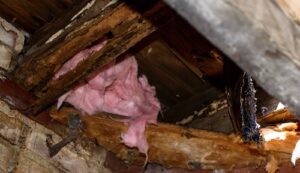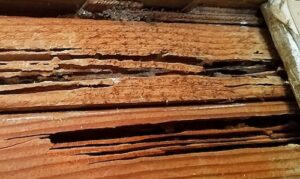The Difference between Termite Damage and Water Damage
If you’re a homeowner, you might have felt the panic of realizing that the weather or some other cause has damaged your house. Damage in your home is never a welcome sight, but it’s something every homeowner will probably have to deal with at some time or another. We see two types of damage quite a bit in homes: termite damage and wood damage. A question we hear a lot is, “how can you tell the difference between the two?” The difference between termite damage and water damage (and how to treat the two) is in the damaged area’s exact pattern and look. Termite damage will leave the wood with wavy grooves or looking hollowed out, while water damage will most likely cause a darker area, a weird smell, and even some possible mold or mildew.
Because of wood prominence in almost every home (think walls, furniture, floors, etc.), both termite and water damage can run rampant in houses.
However, both types of damage have very similar symptoms. Both types of damage can cause bubbles to form in paint or even breakage.
So you’ve looked at the damage that’s causing problems in your home. If you’ve determined which type of damage it is, let’s take a closer look into what exactly is happening and how best to fix it.
Signs of Water Damage
We want only one type of water in our house: good hot running water for a relaxing bath, or maybe water boiling for the tea kettle. We certainly don’t want water leaking through roofs, walls, or windows and causing our home’s wood to get soggy. Soggy wood eventually leads to rot. Wood rot is the eventual conclusion of water damage, and it can wreak havoc with your home. Ways to identify wood rot are listed below:
- Darkened area of wood: If there is an area of wood that sticks out to you, it could very well be from a water leak. Although some variations of color are normal in wood, an intense spot of darker color is a sign that something is very different about that specific area.
- Soft and spongy wood: You know when you’re in the bathtub too long, and you turn all spongy and wrinkled? Well, wood does the same thing. Except it also turns soft and absorbent, like it’s your wet sponge instead of a piece of strong, protective wood.
- Cracked and crumbly wood: As we said, wood that gets too wet gets gross, soft, and wrinkly. This is the wrinkly part. Water can cause the paint to peel and wood to crumble much more quickly than before the wood rot set in.
- Localized mold or fungus: Thankfully, when we take baths, we don’t get fungus springing up, but wood does. Fungus and mold love water, and they especially love wood and water together. It’s their favorite meal, so if you happen to see fungus in one area of your wood, beware.
- A gross, damp smell: Dampness has a very distinct odor, and the musky scent of mold might also accompany this. Look out for smells in conjunction with other indicators of water damage.
- A dripping or a leak: then this can leave pools of water. If you notice an unusual puddle, then keep an eye on it to see if it comes back after you clean it up. If it does, then you may have a leak or seepage.
- If your home is complicated to heat, then this might be a sign that you have dampness affecting your walls. Water and moisture will often draw heat out of walls to evaporate, which, in turn, leaves those walls and the property overall much colder.
 Occasionally, we’ve seen cases when the water damage wasn’t visible, but it was audible. The odd sound of water dripping somewhere it shouldn’t be when it shouldn’t, or even a strange creak that was never there before. Remember that you aren’t just searching for sounds; you’re searching for sounds that have never been there before. A creaky floorboard is not usually a cause for concern, but an odd creaking noise emanating from somewhere unusual is, well, unique. If you notice a sound like that, it’s time to put on your detective and become the sherlock holmes of home experts.
Occasionally, we’ve seen cases when the water damage wasn’t visible, but it was audible. The odd sound of water dripping somewhere it shouldn’t be when it shouldn’t, or even a strange creak that was never there before. Remember that you aren’t just searching for sounds; you’re searching for sounds that have never been there before. A creaky floorboard is not usually a cause for concern, but an odd creaking noise emanating from somewhere unusual is, well, unique. If you notice a sound like that, it’s time to put on your detective and become the sherlock holmes of home experts.
Follow the sound, find the sound, and determine if there’s a possibility it could indeed be water. The first step with dealing with this wood rot that has infested your home is to first stop the flow of water to wherever it is going. This might require professional help, but you may be able to do it on your own. If the leak is coming from the roof, it may be time for new shingles. If it’s coming from a wall, it might be time to fix the wall and ensure any place water could get inside is closed. If you can stop water flow, you can replace or reinstall the wood pieces with brand new wood that hasn’t been compromised with water.
If you need to, though, we always recommend hiring a professional Broken Arrow Construction company for important fixes like this. Saving your home from wood rot isn’t just a DIY project on Pinterest, but a top-priority goal that should get done quickly and correctly. This is why it could be an excellent option to look into hiring a professional.
Signs of Termite Damage
As we mentioned above, termite damage looks slightly different than water damage. Termites will burrow into the wood and often create grooves or hallow the wood out. Although termites can look like water damage because their nests often have high-moisture levels, they will need to be treated differently. Once you have finally decided what type of damage your home has, you can take the next step in saving your home’s wood from termites or water!
With termites, it gets even more complicated since different kinds react differently to a treatment. The two main types of termites you will find in the U.S. are called dry wood and subterranean termites. Sub terranean termites are very damaging, and they tunnel into your foundational wood, soil, and composts. They create “highways” by eating through mud or wood, bringing entire buildings down with them. These termites are often more significant than their dry wood cousins, and if you encounter them, you should immediately get professional help. However, there are a few strategies you could also use for subterranean termites.
 How to Get Rid of Termites
How to Get Rid of Termites
Below is a list of ways to minimize or get rid of subterranean termites:
- Beneficial Nematodes: These are roundworms, which sounds gross, but stick with me. If you have an area of soil infested with subterranean termites and you need to get rid of them, you can purchase these worms and eat the termites. It’s a natural way to get rid of a small infestation of these nasty bugs.
- Termite Baits: Termite baits are what they sound like, a booby trap that snares the termites in and then releases a position to get rid of them. If this is war, then you’ll hopefully be winning.
- Chemicals: There are all sorts of chemicals out there that can be used in your home to get rid of termites. Again, we recommend you consult with a professional. Applying a termite-killing chemical might take a while, but it could be a good option if your house has begun to show signs of termite infestation.
- Boric Acid: Boric acid works to dehydrate termites, effectively killing them. This ingredient is found in most termite-killing sprays anyway, so you can go ahead and get boric acid to start the serious business of getting rid of termites.
- Diatomaceous Earth: This is similar to boric acid in that it naturally dehydrates the termites. This is best used outdoors, but once you sprinkle it on, it should work like a charm in killing termites.
Drywood termites are smaller and less dangerous than their scary cousins. They do not need soil to live, like subterranean termites, and can survive just fine in wood. Drywood termites don’t necessarily take as much to kill, which is excellent. However, we recommend calling professionals if you have an infestation. However, here are some ways to handle small numbers of drywood termites:
- Spot Treatments: You have one area of a wall with drywood termites; you can effectively bomb them using termiticide. All you need to do is drill holes, stuff the termiticide inside the spot, and close it back up with putty. They shouldn’t be able to live.
- Essential Oils: This might sound hippy, but don’t rag on essential oils. Orange oil and neem oil, in particular, seem to be very useful in slowly killing termites. Death isn’t immediate, but it works. Create this mixture, use water as your base, your choice of oil as the main course, and a bit of dish soap to flavor it. Goodbye, termites.
You can use diatomaceous earth or boric acid to kill drywood termites, just like subterranean termites. Owning a home can be a lot of work, and maintenance like getting rid of water damage or termites is unfortunate but a part of life. If you’re a homeowner, pay close attention to the sounds and sights of your home. Be sure to watch out for anything that wasn’t there before. Taking preventative care of your home is a great way to ensure that your home stays safe and sound and you remain aware of anything that could cause problems. And now, at least you know the difference between water damage and termite damage!
